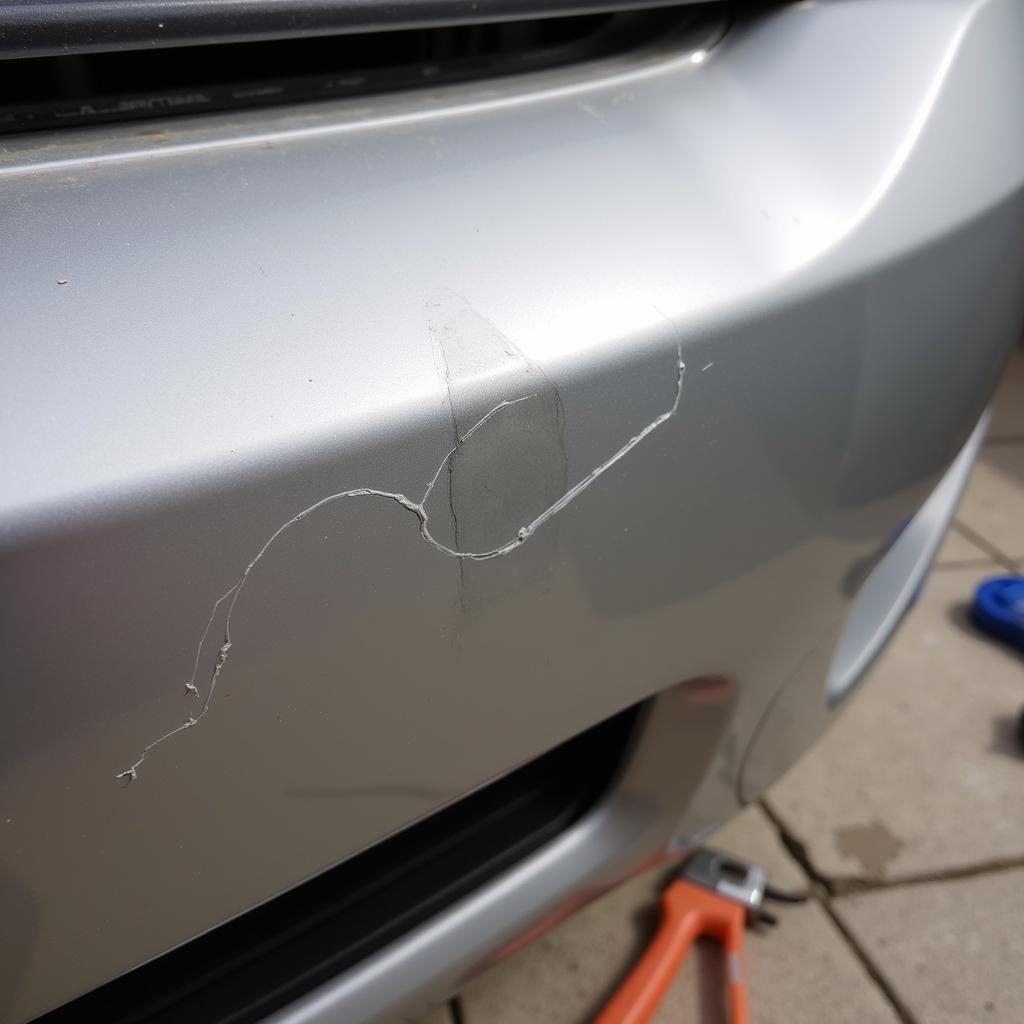Fixing scratches on your plastic car bumper can seem daunting, but with the right approach, it can be a surprisingly straightforward DIY project. This guide provides comprehensive steps and expert advice to help you restore your bumper’s pristine appearance, whether you’re a seasoned mechanic or a first-time car owner.
Assessing the Damage: Light vs. Deep Scratches
Before you begin, it’s crucial to assess the severity of the scratches. Light scratches, often appearing as superficial swirls or scuffs, can usually be addressed with simple techniques like buffing or polishing. Deeper scratches, however, may require more intensive methods like sanding and repainting. Identifying the type of scratch will determine the best course of action. Have you noticed cracks in your leather seats? Check out how to fix cracks in leather car seats for more information.
 Deep scratch on car bumper repair
Deep scratch on car bumper repair
Fixing Light Scratches on Your Car Bumper
For light scratches, start by thoroughly washing and drying the bumper. Then, apply a rubbing compound designed for plastic using a microfiber cloth. Work in small, circular motions, applying gentle pressure. This process can effectively remove minor imperfections and restore the bumper’s shine. Many car owners find this a quick and easy fix.
How to Repair Deep Scratches: A Step-by-Step Guide
Deep scratches require a more involved approach:
-
Clean the Area: Wash and dry the affected area thoroughly to remove any dirt or debris.
-
Sand the Scratch: Using fine-grit sandpaper (around 2000-grit), gently sand the scratch and surrounding area. Sand in the direction of the scratch to avoid creating further damage.
-
Prime (If Necessary): If the scratch has penetrated the paint down to the plastic, apply a plastic primer to promote adhesion of the paint.
-
Apply Paint: Using a touch-up paint that matches your car’s color, carefully apply thin coats to the scratched area. Allow each coat to dry completely before applying the next.
-
Clear Coat: Once the paint is dry, apply a clear coat to protect the repair and restore the bumper’s gloss.
-
Buff and Polish: After the clear coat has cured, buff and polish the repaired area to blend it seamlessly with the rest of the bumper. You might be interested in learning how to fix leather scratches car.
“Proper surface preparation is key to a successful bumper repair,” says automotive expert, Michael Stevens. “Taking the time to clean and sand correctly will ensure optimal adhesion of the primer and paint, leading to a long-lasting and aesthetically pleasing result.”
Preventing Future Scratches
Protecting your bumper from future scratches is always easier than repairing them. Consider using bumper protectors, parking carefully, and avoiding tight spaces to minimize the risk of scratches. This proactive approach can save you time and money in the long run. Looking to fix leather car seat cracks? We have a guide for that too!
Conclusion
Fixing scratches on a plastic car bumper is achievable with the right techniques and a bit of patience. By understanding the severity of the damage and following the appropriate steps, you can restore your bumper’s appearance and maintain your car’s value. For further assistance or specialized repairs, feel free to contact us at AutoTipPro at +1 (641) 206-8880 or visit our office at 500 N St Mary’s St, San Antonio, TX 78205, United States. Do you know how to fix cracking leather car seats?
“Regularly waxing your car, including the bumper, can create a protective layer that helps prevent minor scratches and swirls,” adds Sarah Miller, a seasoned auto detailer. “This simple step can significantly reduce the need for more extensive repairs down the line.” Knowing how to fix antifreeze leak in car is also a valuable skill.
FAQ
-
Can I use any type of rubbing compound on my plastic bumper? No, use a rubbing compound specifically designed for plastic to avoid damage.
-
What grit sandpaper should I use for sanding deep scratches? Start with a finer grit sandpaper, around 2000-grit, to avoid excessive material removal.
-
Do I need to apply primer before painting? Primer is necessary if the scratch is deep enough to expose the bare plastic.
-
How long does it take for the touch-up paint to dry? Drying times vary depending on the product and environmental conditions, so always refer to the manufacturer’s instructions.
-
Can I fix a cracked bumper using these methods? Cracks typically require professional repair or bumper replacement.
-
What can I do to prevent bumper scratches? Park carefully, avoid tight spaces, and consider using bumper protectors.
-
Where can I find touch-up paint that matches my car’s color? Your car’s owner’s manual or a local auto parts store can help you find the correct paint code.




Leave a Reply